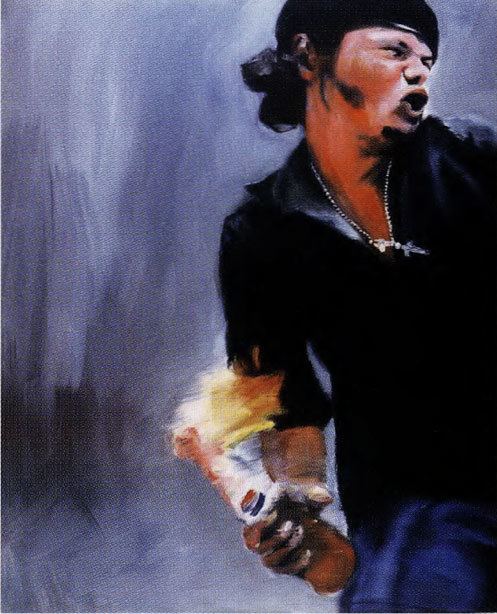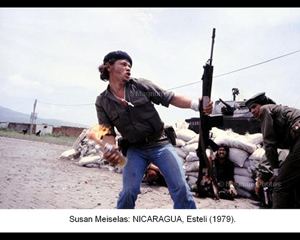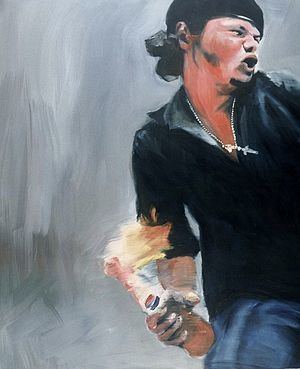Year 2003 Location Private Collection Created 16 July 1979 | Medium Oil on canvas | |
 | ||
Dimensions 178 cm × 152 cm (70 in × 60 in) Similar Saigon Execution, Fire Escape Collapse, The Pond—Moonlight, Untitled (Cowboy), The Steerage | ||
Axial bomber molotov custom rr10 paint
Molotov Man is the title by which a photograph taken by Susan Meiselas during the 1979 Nicaraguan Revolution has come to be known. Famous in its Nicaraguan context as a symbol of the Sandinista revolution, it has been widely reproduced and remixed. Latterly, outside this context, it was reproduced via an internet meme based on Joy Garnett's 2003 painting Molotov, becoming a prominent case-study of re-use of art.
Contents

The photograph depicts a man (later found to be called Pablo 'Bareta' Arauz) poised to throw a Molotov cocktail, made from a Pepsi bottle, in his right hand, while holding a rifle in his left.

The original image
By Meiselas's account,

The image was first published in Meiselas's Nicaragua, June 1978--July 1979.

However, it was subsequently widely reproduced in both pro- and anti-Sandinista propaganda and art. Meiselas herself exhibited the photograph in Nicaragua (along with others from the same collection) at the time of the twentieth anniversary of the revolution, in 1999.
Initial conflict

Joy Garnett's 2004 exhibition Riot featured a series of paintings based on images pulled from mass media sources, depicting figures in "extreme emotional states." One of the paintings, entitled Molotov, was originally sourced from a jpeg of Molotov Man found on the Internet. After the Riot exhibition closed, Meiselas's lawyer contacted Garnett with a cease and desist letter claiming copyright infringement and "piracy" of Meiselas' photograph. The letter stipulated that she remove the image from her website, sign a retroactive licensing agreement to transfer all rights to the painting to Meiselas, and credit Meiselas on all subsequent reproductions of Molotov.

Garnett responded to a threat of injunction by removing the image of Molotov from her website. Once the image was removed from Garnett's website, Meiselas did not pursue the matter further.
Joywar
Before Garnett pulled the image off her website, the story had been picked up by Rhizome.org. Many of Garnett's peers were following the course of events, and were concerned by what they viewed as "one artist using his copyrights as a way to censor another artist." Referencing an earlier legal battle known as Toywar involving similar copyright issues, a group of artists launched a solidarity campaign called Joywar.
The idea behind Joywar was to demonstrate support for Garnett and protection of fair use by copying the Molotov image and reposting it in as many incarnations as possible. After Garnett announced her decision to remove the original image via the forums on Rhizome.org, she was notified that one of her peers had already uploaded a mirror site, or copy of Garnett's original webpage, on his own server. Within a week, countless other mirrors were being uploaded. Other users were encouraged to grab the image, and either repost it or appropriate it in their own artwork.
Word of the cause spread quickly throughout the new media blogosphere. Soon the story was being reposted in French, Italian, Czech, Chinese, Spanish, and Catalan. Derivative works were produced and shared at an exponential rate, protesting against Meiselas's claim of copyright infringement and suggesting that this claim was a means of controlling what many of Garnett's peers regarded as a creative appropriation protected under fair use. Garnett created an online archive to document the origins, reactions, and critiques surrounding Joywar, and the subsequent global proliferation of images that were spurred by the controversy surrounding Garnett’s sampling from Meiselas' photograph.
In April 2006, Garnett and Meiselas were asked to attend the COMEDIES OF FAIR U$E symposium at the New York Institute for the Humanities. After meeting in person for the first time the day before, they gave a side-by-side account of the events surrounding Molotov at the conference. Their presentation was well-received, and an edited transcript was later published in Harper's, February 2007.
In the transcript, Meiselas states that her mission as a photojournalist was to provide a cultural and historical context for the images she captured, which she views as fundamentally different from Garnett's goal as an artist to "decontextualize" the images that she appropriates and remediates in paint. Meiselas mainly objects to the removal of her original subject (whom she identifies as "Molotov Man", later revealed to be a man named Pablo Arauz) from the context of the photo, which she views as disrespectful to the individual himself and believes devalues her original work.
Meiselas claims that "There is no denying in this digital age that images are increasingly dislocated and far more easily decontextualized." Meiselas ultimately believes that while "Technology allows us to do many things ... that does not mean we must do them." Meiselas contends: "I never did sue Joy in the end, nor did I collect any licensing fees. But I still feel strongly, as I watch Pablo Arauz's context being stripped away--as I watch him being converted into the emblem of an abstract riot--that it would be a betrayal of him if I did not at least protest the diminishment of his act of defiance." Others have responded to this, however, by affirming that Pablo Arauz lent his gesture without his knowledge to the Meiselas photograph, which was to become the iconic symbol of the triumphant turning point of the Sandinista Revolution. These critics note that Meiselas does not mention Pablo Arauz anywhere in her photographic essay, Nicaragua, where his image, the image of "Molotov Man," first appeared; it was therefore Meiselas who initially stripped him of his identity as Pablo Arauz in order to convert the figure into an abstract emblem; this necessarily brings up the issue of the suppression of individual identity in the production of a cultural icon.
Garnett, on the other hand, asks "Who owns the rights to this man's struggle?" She questions the legitimacy of an artist's right to dictate who can make commentary on their work and what can be said. On one hand she is concerned with the role that copyright may play in restricting artistic creation, and how to preserve rights of ownership while still allowing for creative appropriation under terms of fair use. But mainly, Garnett is interested in the ways in which painting as a metiér can be wielded to engage issues of mass media-generated culture.
While this particular case was never taken to court, similar conflicts have become subject to drawn-out legal battles. Most cases disputing fair use and copyright infringement in appropriation art have been dealt with on a case-to-case basis, because much of the legislation about what constitutes fair use leaves room for interpretation. The recent case establishing precedent is Blanch v. Koons (2005) between Andrea Blanch, a commercial photographer, and the artist Jeff Koons. The case was decided in Koons' favor, establishing that a visual work of art that has incorporated appropriated imagery is sufficiently "transformative" and therefore protected as a fair use. It trumps the findings of an earlier high-profile case in 1991, Rogers v. Koons which involved another instance of Koons being accused of copyright infringement by the author of the sourced image. Koons argued that his work fell under fair use by parody, which was rejected at the time.
